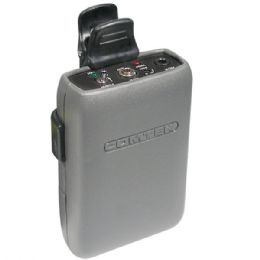







~1.jpg&newheight=260&quality=80)











What are Personal Listening System Accessories?
Personal listening system accessories are supplemental devices that help individuals with auditory communications. For example, a hearing aid is a personal listening device, but it may not offer enough auditory assistance. Background noise and poor room acoustics can incur listening challenges for even the best hearing aid to overcome. Therefore, additional listening devices can be helpful. One-to-one communicators are a kind of personal listening device accessory. A one-to-one communicator is a system which allows a person to hear only what one specific person is saying, usually through a set of headphones or a hearing aid. The speaker talks into a microphone and the sounds are then communicated directly into the communicator device. These types of assistive products are helpful during lectures, providing hearing impaired students with an invaluable resource.
Personal frequency modulation (FM) systems are a kind of personal listening device accessory. These systems work with specific frequencies which have been dedicated to listening devices by the Federal Communications Commission (FCC), and work like miniature radio stations. The speaker uses a transmitter that communicates directly to the personal listening device or hearing aid. Many places have found great success in improving communication through personal FM systems, such as lecture halls, theaters, and places of worship.
What is a Wired Headset?
A wired headset is a set of headphones that are connected to either a computer or telephone using a wire connection, and this connection is normally made through a USB plug or a headphone jack. A wired headset enables the user to both speak and listen using one piece of equipment. Sometimes, the headphones and microphone use a single connection to attach to the electronic device, while other wired headsets use separate wires for the two components.
A wired headset can be worn around the back of the neck, over the head, or looped around the ears, much like the varieties of headphones that are available. Often, there is confusion concerning the function of the two devices. The major difference between headsets and headphones is that headsets are designed for two-way communication while headphones are solely made for listening to audio.
Wired headsets can come with one or two headphones; one is known as monaural and two is known as binaural. Monaural headsets copy the act of speaking on the telephone and binaural headsets give stereo sound, which is preferred by video gamers. The microphone may be either omni-directional or noise-canceling. Omni-directional means that sound from all directions will be captured, which causes it to transmit a higher quality sound. Noise-canceling means the wired headset will only pick up sound from two small regions; directly in front of, and behind the microphone. This enables it to transmit a more specific sound, making it a good choice for an individual who is having a conversation in a noisy environment. The difference between these components should be taken into consideration, depending on the personal usage that is intended for the headset.
To minimize strain on the neck from speaking while tilted over a telephone receiver, those who work at telephone call centers commonly use a wired headset. This type is also commonly used with cell phones when hands-free communication is preferred or required, usually through a USB port. Other users include those who use voice over internet protocol, also known as VoIP, or internet telephony. Online video gamers who like to chat with other players while keeping their hands free for gaming are common users of wired headsets.
What are Wireless Headphones?
Wireless headphones are small electronic speakers that a user can wear close to the ears to hear sounds provided by a device, but are not connected to it by wires. The sounds are typically transmitted from a device to the headphones using radio frequency waves. Some early versions transmitted the sounds by using infrared signals. The headphones can be as small as earbuds that fit snugly into the ear canals, or as large as padded cups that cover the ears. Wireless headphones can receive a signal up to a certain distance away from the source device, usually at least 100 feet away.
These types of headphones are convenient for use during activities when wires would get in the user’s way. For example, someone who is doing basic housecleaning or aerobic exercise might be able to move the arms more freely without getting tangled in the headphone wires. Wireless headphones are able to be somewhat secured to the user’s ears or head, such as with hooks that curl over the tops of the ears, or a strap that goes over the top of the head. This way, the user does not have to worry about them falling off during normal activities.
Many people use wireless headphones with small devices that are attached to their bodies, such as held in a pocket, clipped to a belt, or in a special holder that is designed for the device. Or, it can be convenient at times for a device to be placed somewhere nearby. This can allow the user to perform activities or move around more freely without damaging the device. As long as the headphones’ range is not exceeded, the user can move to other rooms if necessary. Wireless headphones can also be utilized with large source devices that cannot practically be moved along with the user from place to place, such as video game consoles or stereo systems.
There has been government legislation regarding education and hearing impaired students. Hearing impaired children have the right to assistive listening devices that will allow them to understand their teachers and other relating instruction, according to the American Disabilities Act, the Individuals with Disabilities Education Act, and Section 504 of the Rehabilitation Act.
Hulet Smith, OT
Rehabmart Co-Founder & CEO
lb